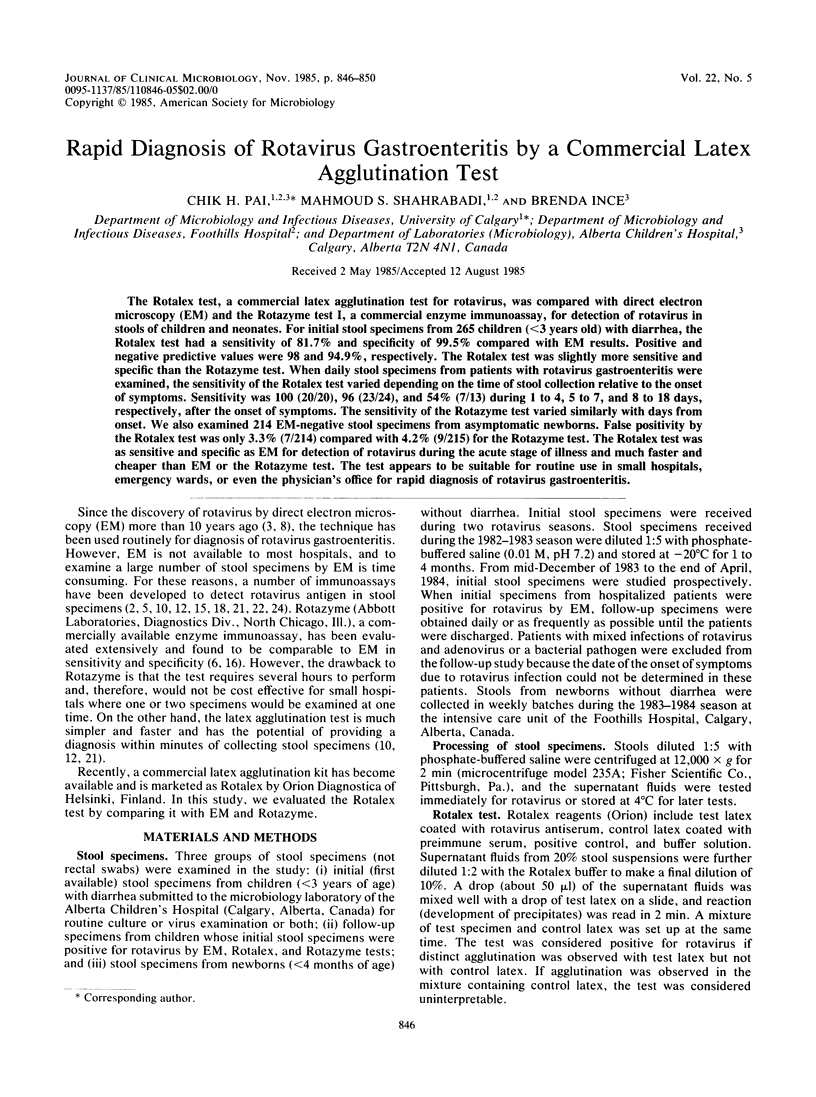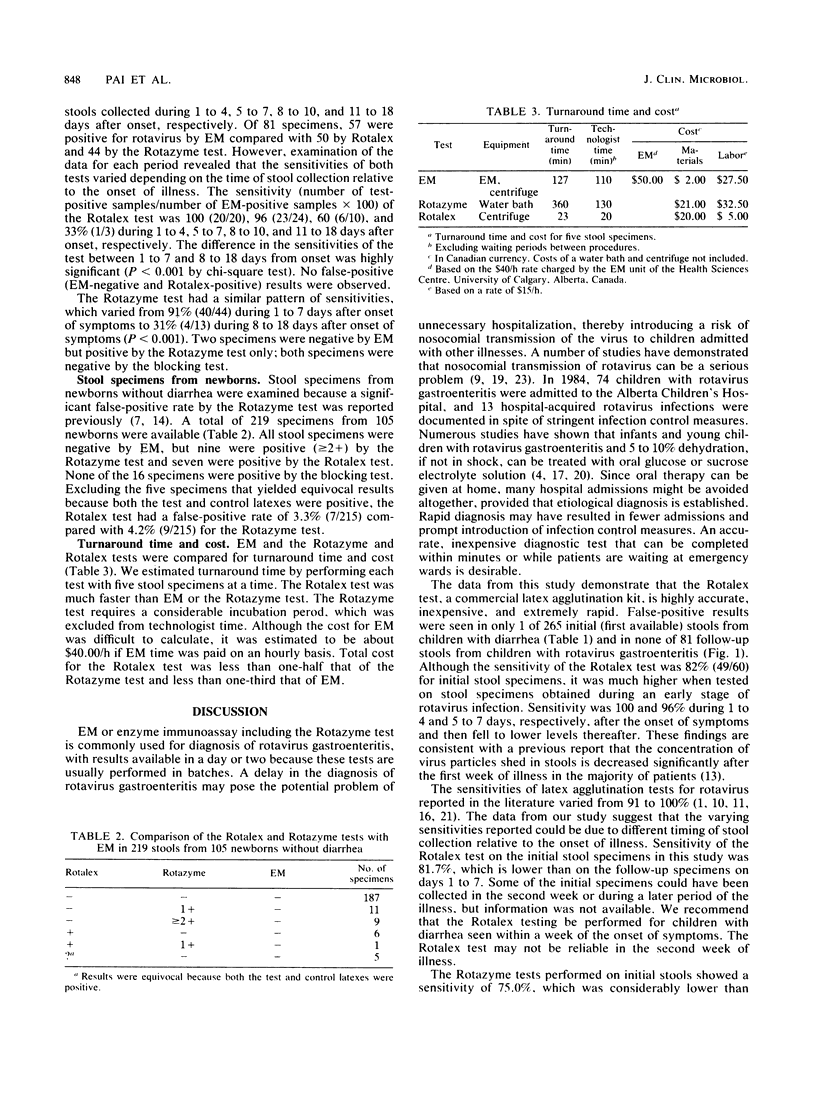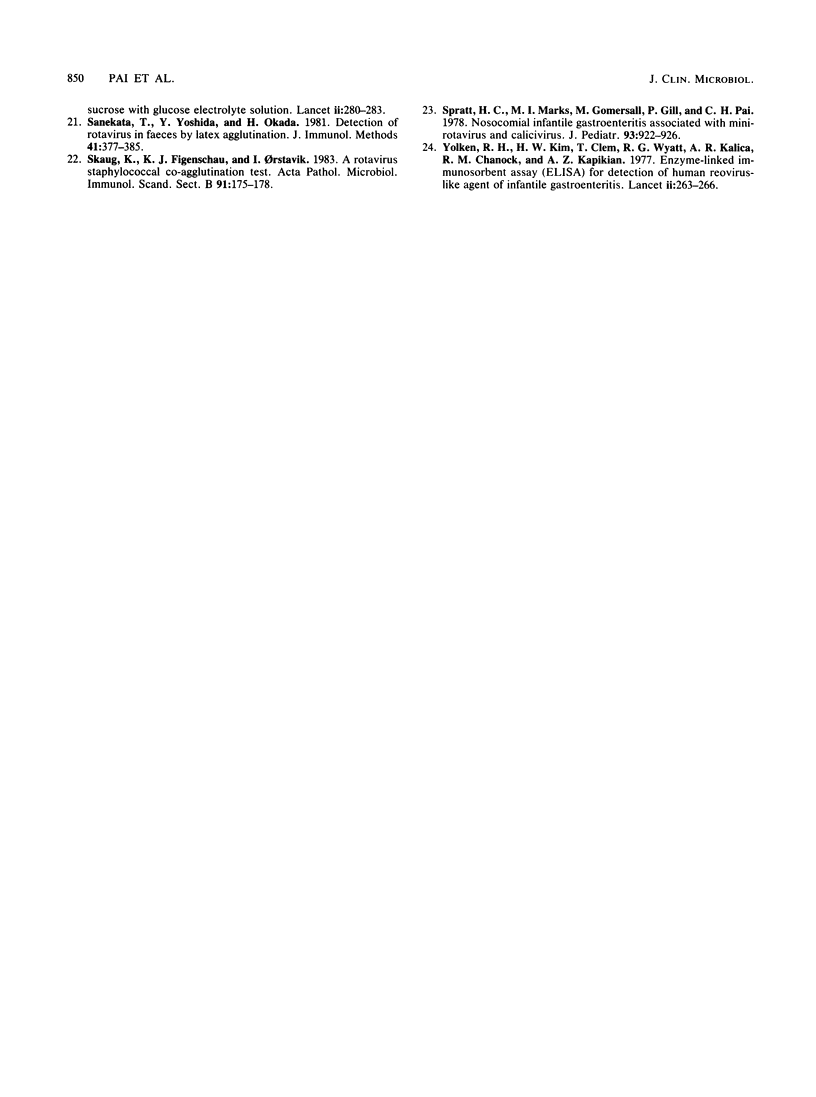Abstract
The Rotalex test, a commercial latex agglutination test for rotavirus, was compared with direct electron microscopy (EM) and the Rotazyme test I, a commercial enzyme immunoassay, for detection of rotavirus in stools of children and neonates. For initial stool specimens from 265 children (less than 3 years old) with diarrhea, the Rotalex test had a sensitivity of 81.7% and specificity of 99.5% compared with EM results. Positive and negative predictive values were 98 and 94.9%, respectively. The Rotalex test was slightly more sensitive and specific than the Rotazyme test. When daily stool specimens from patients with rotavirus gastroenteritis were examined, the sensitivity of the Rotalex test varied depending on the time of stool collection relative to the onset of symptoms. Sensitivity was 100 (20/20), 96 (23/24), and 54% (7/13) during 1 to 4, 5 to 7, and 8 to 18 days, respectively, after the onset of symptoms. The sensitivity of the Rotazyme test varied similarly with days from onset. We also examined 214 EM-negative stool specimens from asymptomatic newborns. False positivity by the Rotalex test was only 3.3% (7/214) compared with 4.2% (9/215) for the Rotazyme test. The Rotalex test was as sensitive and specific as EM for detection of rotavirus during the acute stage of illness and much faster and cheaper than EM or the Rotazyme test. The test appears to be suitable for routine use in small hospitals, emergency wards, or even the physician's office for rapid diagnosis of rotavirus gastroenteritis.
Full text
PDF




Selected References
These references are in PubMed. This may not be the complete list of references from this article.
- Agius G., Baillargeau E., Castets M., Samb A. Détection rapide des rotavirus dans les selles. Intérêt d'un test au latex. Pathol Biol (Paris) 1984 Jan;32(1):56–58. [PubMed] [Google Scholar]
- Beards G. M., Campbell A. D., Cottrell N. R., Peiris J. S., Rees N., Sanders R. C., Shirley J. A., Wood H. C., Flewett T. H. Enzyme-linked immunosorbent assays based on polyclonal and monoclonal antibodies for rotavirus detection. J Clin Microbiol. 1984 Feb;19(2):248–254. doi: 10.1128/jcm.19.2.248-254.1984. [DOI] [PMC free article] [PubMed] [Google Scholar]
- Black R. E., Merson M. H., Taylor P. R., Yolken R. H., Sack D. A. Glucose vs sucrose in oral rehydration solutions for infants and young children with rotavirus-associated diarrhea. Pediatrics. 1981 Jan;67(1):79–83. [PubMed] [Google Scholar]
- Brandt C. D., Kim H. W., Rodriguez W. J., Thomas L., Yolken R. H., Arrobio J. O., Kapikian A. Z., Parrott R. H., Chanock R. M. Comparison of direct electron microscopy, immune electron microscopy, and rotavirus enzyme-linked immunosorbent assay for detection of gastroenteritis viruses in children. J Clin Microbiol. 1981 May;13(5):976–981. doi: 10.1128/jcm.13.5.976-981.1981. [DOI] [PMC free article] [PubMed] [Google Scholar]
- Cheung E. Y., Hnatko S. I., Gunning H., Wilson J. Comparison of Rotazyme and direct electron microscopy for detection of rotavirus in human stools. J Clin Microbiol. 1982 Sep;16(3):562–563. doi: 10.1128/jcm.16.3.562-563.1982. [DOI] [PMC free article] [PubMed] [Google Scholar]
- Chrystie I. L., Totterdell B. M., Banatvala J. E. False positive rotazyme tests on faecal samples from babies. Lancet. 1983 Oct 29;2(8357):1028–1028. doi: 10.1016/s0140-6736(83)91014-0. [DOI] [PubMed] [Google Scholar]
- Flewett T. H., Bryden A. S., Davies H. Letter: Virus particles in gastroenteritis. Lancet. 1973 Dec 29;2(7844):1497–1497. doi: 10.1016/s0140-6736(73)92760-8. [DOI] [PubMed] [Google Scholar]
- Haikala O. J., Kokkonen J. O., Leinonen M. K., Nurmi T., Mäntyjärvi R., Sarkkinen H. K. Rapid detection of rotavirus in stool by latex agglutination: comparison with radioimmunoassay and electron microscopy and clinical evaluation of the test. J Med Virol. 1983;11(2):91–97. doi: 10.1002/jmv.1890110202. [DOI] [PubMed] [Google Scholar]
- Hammond G. W., Ahluwalia G. S., Hazelton P. R. Detection of human rotaviruses in fecal specimens by a commercial latex-agglutination test. J Infect Dis. 1984 Jun;149(6):1021–1021. doi: 10.1093/infdis/149.6.1021. [DOI] [PubMed] [Google Scholar]
- Hughes J. H., Tuomari A. V., Mann D. R., Hamparian V. V. Latex immunoassay for rapid detection of rotavirus. J Clin Microbiol. 1984 Sep;20(3):441–447. doi: 10.1128/jcm.20.3.441-447.1984. [DOI] [PMC free article] [PubMed] [Google Scholar]
- Konno T., Suzuki H., Imai A., Ishida N. Reovirus-like agent in acute epidemic gastroenteritis in Japanese infants: fecal shedding and serologic response. J Infect Dis. 1977 Feb;135(2):259–266. doi: 10.1093/infdis/135.2.259. [DOI] [PubMed] [Google Scholar]
- Krause P. J., Hyams J. S., Middleton P. J., Herson V. C., Flores J. Unreliability of Rotazyme ELISA test in neonates. J Pediatr. 1983 Aug;103(2):259–262. doi: 10.1016/s0022-3476(83)80361-8. [DOI] [PubMed] [Google Scholar]
- Middleton P. J., Holdaway M. D., Petric M., Szymanski M. T., Tam J. S. Solid-phase radioimmunoassay for the detection of rotavirus. Infect Immun. 1977 May;16(2):439–444. doi: 10.1128/iai.16.2.439-444.1977. [DOI] [PMC free article] [PubMed] [Google Scholar]
- Morinet F., Ferchal F., Colimon R., Pérol Y. Comparison of six methods for detecting human rotavirus in stools. Eur J Clin Microbiol. 1984 Apr;3(2):136–140. doi: 10.1007/BF02014331. [DOI] [PMC free article] [PubMed] [Google Scholar]
- Morris C. A., Flewett T. H., Bryden A. S., Davies H. Epidemic viral enteritis in a long-stay children's ward. Lancet. 1975 Jan 4;1(7897):4–5. doi: 10.1016/s0140-6736(75)92370-3. [DOI] [PubMed] [Google Scholar]
- Nalin D. R., Levine M. M., Mata L., de Cespedes C., Vargas W., Lizano C., Loria A. R., Simhon A., Mohs E. Comparison of sucrose with glucose in oral therapy of infant diarrhoea. Lancet. 1978 Aug 5;2(8084):277–279. doi: 10.1016/s0140-6736(78)91686-0. [DOI] [PubMed] [Google Scholar]
- Rubenstein A. S., Miller M. F. Comparison of an enzyme immunoassay with electron microscopic procedures for detecting rotavirus. J Clin Microbiol. 1982 May;15(5):938–944. doi: 10.1128/jcm.15.5.938-944.1982. [DOI] [PMC free article] [PubMed] [Google Scholar]
- Ryder R. W., McGowan J. E., Hatch M. H., Palmer E. L. Reovirus-like agent as a cause of nosocomial diarrhea in infants. J Pediatr. 1977 May;90(5):698–702. doi: 10.1016/s0022-3476(77)81230-4. [DOI] [PubMed] [Google Scholar]
- Rzedzian R., Chapman B., Mansfield P., Coupland R. E., Doyle M., Chrispin A., Guilfoyle D., Small P. Real-time nuclear magnetic resonance clinical imaging in paediatrics. Lancet. 1983 Dec 3;2(8362):1281–1282. doi: 10.1016/s0140-6736(83)91153-4. [DOI] [PubMed] [Google Scholar]
- Sanekata T., Yoshida Y., Okada H. Detection of rotavirus in faeces by latex agglutination. J Immunol Methods. 1981;41(3):377–385. doi: 10.1016/0022-1759(81)90199-x. [DOI] [PubMed] [Google Scholar]
- Skaug K., Figenschau K. J., Orstavik I. A rotavirus staphylococcal co-agglutination test. Acta Pathol Microbiol Immunol Scand B. 1983 Jun;91(3):175–178. doi: 10.1111/j.1699-0463.1983.tb00029.x. [DOI] [PubMed] [Google Scholar]
- Spratt H. C., Marks M. I., Gomersall M., Gill P., Pai C. H. Nosocomial infantile gastroenteritis associated with minirotavirus and calicivirus. J Pediatr. 1978 Dec;93(6):922–926. doi: 10.1016/S0022-3476(78)81212-8. [DOI] [PMC free article] [PubMed] [Google Scholar]
- Yolken R. H., Kim H. W., Clem T., Wyatt R. G., Kalica A. R., Chanock R. M., Kapikian A. Z. Enzyme-linked immunosorbent assay (ELISA) for detection of human reovirus-like agent of infantile gastroenteritis. Lancet. 1977 Aug 6;2(8032):263–267. doi: 10.1016/s0140-6736(77)90951-5. [DOI] [PubMed] [Google Scholar]


